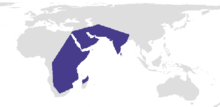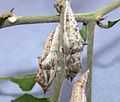Belenois aurota
| Pioneer White or Brown-veined White[1] | |
|---|---|
_male.jpg) | |
| Male B. a. aurota, uMkhuze Game Reserve, KwaZulu Natal, South Africa | |
_female.jpg) | |
| female B. a. aurota, Tswalu Kalahari Reserve, South Africa | |
| Scientific classification | |
| Kingdom: | Animalia |
| Phylum: | Arthropoda |
| Class: | Insecta |
| Order: | Lepidoptera |
| Family: | Pieridae |
| Genus: | Belenois |
| Species: | B. aurota |
| Binomial name | |
| Belenois aurota (Fabricius, 1793) | |
 | |
| Distribution range of Belenois aurota | |
| Synonyms | |
| |
The Pioneer White or African Caper White (Belenois aurota) is a small to medium-sized butterfly of the Family Pieridae, that is, the Yellows and Whites, which is found in South Asia and Africa. In Africa, it is also known as the Brown-veined White, and is well known during summer and autumn when large numbers migrate north-east over the interior.
Description
- See glossary for terms used
Wet-season form
The upperside of males is white with the forewing having the costa from base to base of vein 11 dusky black and then jet black continuing into a widened and curving short streak along the disco-cellulars to the lower apex of the cell; apical area diagonally with the termen black, the former with six elongate outwardly pointed spots of the ground-colour enclosed one in each of the interspaces 3, 4, 5, 6, 8, and 9. Hind wing: uniform, the black along the venation on the underside seen through by transparency; termen between veins 2 and 6 somewhat broadly black, with a series of four round spots of the ground-colour in the interspaces; below vein 2 and above vein 6 the termen is very narrowly black. Underside: fore wing white, markings similar, more clearly defined, the white spots within the black apical area larger. Hind wing: yellowish white, all the reins very broadly bordered with black; interspaces 1, 2, 6, and 7 with cross-bars of black, beyond which there is a subterminal, somewhat broad, transverse band of black between veins 2 and 6. Cilia of both fore and hind wings white alternated with black. The ground-colour on both upper and under sides variable, often cream-coloured above; beneath: in some specimens, the base of cell and the elongate spots in apical area of fore wing, and the whole surface of the hind wing varies to rich chrome-yellow.[2]
Female similar; the black markings on both upper and under sides broader, the white spots on black apical area of fore wing often sub-obsolete above.
Antennae in both sexes black, sparsely sprinkled with white dots; head, thorax and abdomen above and below white: thorax above often bluish grey.
-
_I_IMG_0407.jpg)
Wet season form in Kolkata, West Bengal, India
-
_in_Hyderabad%2C_AP_W_IMG_0324.jpg)
Wet-season form in Hyderabad, India
-
_mating_W_IMG_9503.jpg)
Wet-season form - mating in Hyderabad, India
Dry-season form
Similar to wet-season form but on the upperside the black markings are narrower, the white markings on the black apical area of fore wing broader and longer, and on the hind wing the narrow inner margining to the black on the termen very narrow, somewhat obsolescent; therefore, the white subterminal spots have the appearance of opening inwards. Underside: ground-colour almost pure white; on the hind wing slightly tinged with yellow. Antennae, head, thorax, and abdomen as in the wet-season form.[2]
Wing expanse of 44–62 mm.
Race taprobana, Moore. (Sri Lanka) Differs from the typical form as follows: Male upperside, fore wing: deep black on apical area, the enclosed white elongate spots more or less obsolete. Hind wing: the black terminal border much broader and of a deeper black, the enclosed white spots, except the spot in interspace 6, very much smaller, somewhat obsolescent, sometimes absent in interspace 4. Underside: similar to the upperside, the markings of a very intense black and broader, the enclosed spots in the apical area of fore wing, the white of the cell and the area along the upper half of the wing generally overlaid with rich chrome-yellow. Hind wing: ground-colour a deep rich chrome-yellow, the spots on it enclosed in the black along terminal margin subhastate, the spot in interspace 4 absent.[2]
Female Similar to the male on both upper and under sides, but in most specimens, on the upperside, the spots of the white ground-colour that are enclosed in the black apical area of the fore wing and the spots on the black border along the terminal margin of the hind wing are entirely absent.[2]
-

Dry-season form in Kullu District of Himachal Pradesh, India
-
_I_IMG_6406.jpg)
Dry-season form in Kullu District of Himachal Pradesh, India
Distribution
_white_rhino_dung.jpg)
Sri Lanka, the Himalayas from Kashmir to Sikkim at elevations below 6000 feet, and through the plains to Southern India. In the Nilgiris observed up to 8000 feet (Hampson). To the west it spreads through Persia and Arabia to East Africa.[2] The species occurs over the greater part of sub-Saharan Africa.
It does not seem to occur in Assam or Burma, but I possess a specimen of the dry-season form taken by Mr. G. Kogers, Deputy Conservator of Forests, in April 1903, in the Ganges harbour, Great Nicobar Island.—Bingham, C. T. 1907
Life cycle
Food plants of the larvae include Capparis zeylanica.[3] In Africa, the host plants are almost exclusively from the family Capparaceae and in particular the genera Boscia, Maerua and Capparis. Eggs are laid in batches of 20 or so, while the newly hatched larvae are gregarious.
Larva
When hatched a line long, olive colour, with a distinct glossy jet-black head. After first moult. One fourth inch long; grass-green ; dorsal line very distinct, dark green ; lateral line very broad, plum-coloured and mottled, dentated into the ground- colour, on the last two segments on its upperside ; a small white spot on either side of dorsal line on each segment; a yellow spot on each segment on the lateral line on either side ; abdomen glossy green ; ventral line distinct, rather interrupted, grass-green ; all the legs green, hairy ; head shiny black with a greentriangular mark in front, covered with stiff whitish hairs ; stigmata dark-coloured ; sides greyish green, slightly wrinkled transversely ; the portion of ground-colour between lateral and dorsal line slightly powdered with yellow ; hair whitish grey ; anal segment black and hairy ; first segment rather swollen in front. After last moult length 1.25 inch long; cylindrical, broader towards the head, slightly tomentose on back, hairy on the sides ; otherwise as after first moult Food- plant, the pea-leaved Caper (Capparis pyrifolia).
—Capt. H. L. Chaumette quoted in Moore and republished by Bingham 1907
Pupa
Five-eighths of an inch long, transparent, pale cream-colour. In front a longish tubercle directed forwards, with a black mark on each side, and a smaller one on either side of 4th segment perfectly black ; a lateral line of pale plum-colour, on which is a longitudinal line of yellow round dots, one on each segment, and a transverse row of dots on each segment ; dashed and marked with black, particularly on the abdomen. After the escape of the imago, the 5th and 6th segments of the pupa become blood-red.—Capt. H. L. Chaumette quoted in Moore and republished by Bingham, 1907
-

Eggs
-
Early instar caterpillars
-

Caterpillar
-
Final instar caterpillar
-

Pupa
Notes
- ↑ Woodhall, S. (2005) Field Guide to Butterflies of South Africa. Cape Town:Struik Publishers. p.336.
- ↑ 2.0 2.1 2.2 2.3 2.4 Bingham, C. T. (1907) Fauna of British India. Butterflies. Vol. 2.
- ↑ Kunte, K. (2006) Additions to known larval host plants of Indian butterflies. J. Bombay Nat. Hist. Soc. 103(1):119-120.
Gallery
See also
References
- Evans, W.H. (1932) The Identification of Indian Butterflies. (2nd Ed.) Bombay Natural History Society, Mumbai, India
-
 Media related to Belenois aurota at Wikimedia Commons
Media related to Belenois aurota at Wikimedia Commons
_W_IMG_0387.jpg)
_mating_W_IMG_9492.jpg)